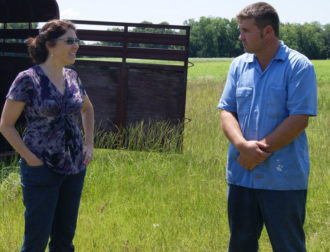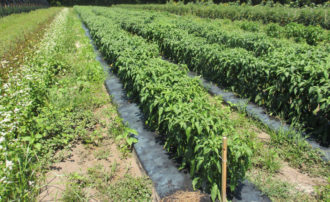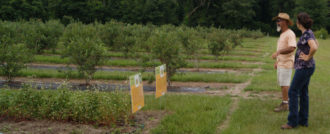LIVE OAK, Florida – Two small farmers in Live Oak, Florida are partnering with University of Florida Extension to determine how cover crops can be used to manage insect pests.
In a newly funded Southern Sustainable Agriculture Research & Education (SSARE) On-Farm Research Grant, “Establishing and Evaluating Selected Cover Crops on Small Farms to Increase the Impact of Beneficial Arthropods on Crop Pests (OS13-079),” strips of sunflower and buckwheat are being incorporated into crop fields to act as trap crops for pests, and as attractants for beneficial predatory insects and pollinators.
“We are trying to find out what we can do to limit our chemical applications,” said Bradley Hoover, of Hoover Farms. The young farmer owns 20 acres of about 50 different types of vegetables, all certified organically grown and sold in the wholesale market. “The benefit of using plants to manage pests has not yet been realized on the farm, and that’s what we are trying to do here. For example, what beneficial insects are attracted to buckwheat and how are they managing pests?”
In his field of tomatoes and peppers, Hoover, with the help of University of Florida Extension agents Bob Hochmuth, Elena Toro, and program coordinator Lei Lani Davis, has planted rows of sunflowers and buckwheat along the field perimeters, as well as additional rows of buckwheat in the center. The study compares the cover crops to the control (no cover crop plantings) to see where they fit into Integrated Pest Management (IPM) practices.
Davis said that the sunflower attracts stinkbugs, specifically the leaf-footed bug, which aggressively attacks tomatoes and peppers.
“The sunflower is acting as a trap crop, keeping the pest away from the farm’s cash crop,” said Davis.
In addition, buckwheat attracts a wide array of beneficial insects, including native pollinators.
Across town, near Wellborn, Scott and Billie Rooney with Rooney’s Front Porch Farm, are looking at the same two cover crops, but evaluating their effectiveness in fruit production. Stinkbugs easily make a meal of their U-pick blackberry and blueberry plants.
“We are only in our first year of the study, but we are not seeing as many stinkbugs in the berries as we’ve had in the past,” said Billie Rooney.
Billie and her husband have already made some keen observations participating in the project. For example, she said that the sunflowers bordering the woodland contain more leaf-footed bugs than the sunflowers bordering their hair sheep grazing pasture.
“Is there something in the woods that’s acting as an overwintering host for the leaf-footed bug? We’d like to find out more about where they are coming from,” said Rooney.
Davis said that the Rooneys are also interested in planting a winter small grain known as triticale in their grazing pastures. Triticale, it turns out, also acts as a trap crop for stinkbugs and will attract the early flights of stinkbugs before the sunflower crop is planted and ready.
“We are treating this first year of the two-year study as a learning curve,” said Davis. “We want to see what will work best for the grower to manage pests and reduce pesticide use.”
--30--
Published by the Southern Region of the Sustainable Agriculture Research and Education (SARE) program. Funded by the USDA National Institute of Food and Agriculture (NIFA), Southern SARE operates under cooperative agreements with the University of Georgia, Fort Valley State University, and the Kerr Center for Sustainable Agriculture to offer competitive grants to advance sustainable agriculture in America's Southern region.


